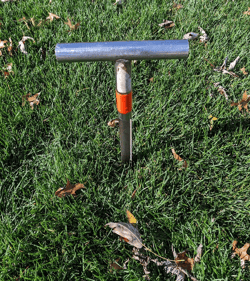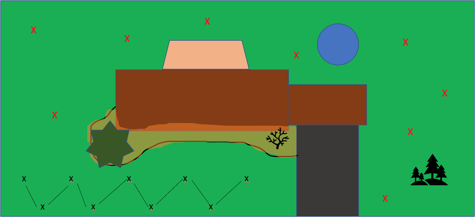
Some states will also require these results for fertilizer programs and legal phosphorus applications. Without the data, one can only guess at what is available to the plant. Making random applications of fertilizer seems somewhat irresponsible in terms of environmental protection.
For all of these reasons, soil testing should be an integral part of your regular business, not to mention that it can be a chargeable service. Furthermore, soil sampling will also instill a professional image of their lawn care company in the customers’ eyes and cement them as a trusted partner.
In order to conduct soil sampling, a few things are required. Generally speaking, we recommend using a soil probe to acquire sub samples. A clean bucket comes in handy to deposit the cores and later crush and mix up, giving you the composite sample. The last would be a sample bag, often provided by the lab.
These samples, or cores, should be taken from multiple areas of the lawn or beds depending on what is to be tested, and samples from different areas should not be mixed as there may be some differentiation in recommendations.

In terms of athletic fields or golf courses, samples from each field, putting green, or other area should be tested separately. We also want the soil being tested to be indicative of where the roots are growing soil so focusing on 3-to-4-inch cores below the thatch layer should be included.
Most importantly, remember the old adage… garbage in, garbage out. Make sure to only include soil for the best possible results. Thatch, plant material, and other debris should be discarded so they do not skew the testing.
For ornamental beds, a 6-inch sample core will be a better representative as many of these plant roots will grow in deeper soil. You can break up the samples and include at least 1 1/2 cups for testing. Make sure to completely and accurately fill out the information form for the best possible recommendations.
Timing is also a critical factor. One should wait a minimum of two weeks following any type of fertilizer or soil amendment application to the area to be tested. Also, for many contractors and lawn applicators, business is slowing down so soil testing can result in an up-tick in revenue.
In addition, this type of testing can be used as a planning tool for what to do or not do for the upcoming season. Lastly is timing of soil amendments–fall is the best time for lime applications and spring for sulfur. These operations can be performed with the help of your testing results, which can be ready in as few as a couple of days or in some cases a couple of weeks depending on how they are delivered and the workload of the lab. Give yourself a little bit of time to plan.
For further interpretation, you can send the results to us. Contact the Ewing Technical Services Team for assistance.




